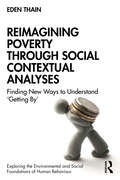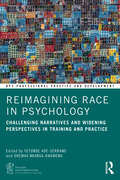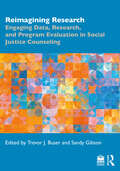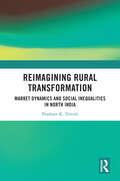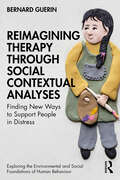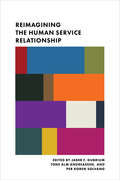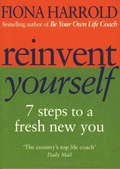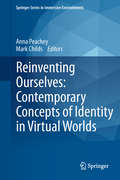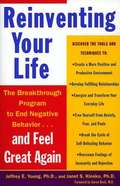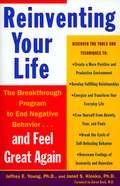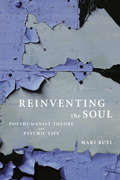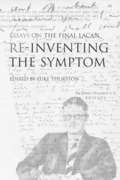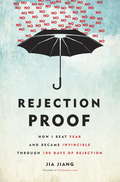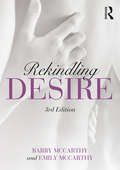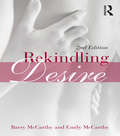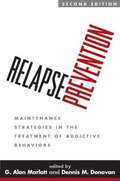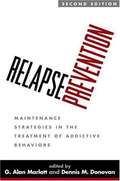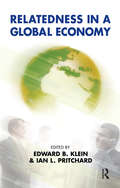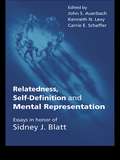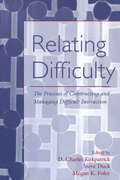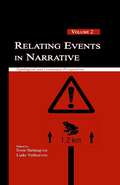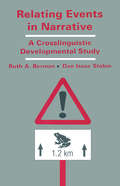- Table View
- List View
Reimagining Poverty through Social Contextual Analyses: Finding New Ways to Understand ‘Getting By’ (Exploring the Environmental and Social Foundations of Human Behaviour)
by Eden ThainThis book is the first of its kind to apply social contextual analysis to the issue of poverty. It sets out detailed accounts of poverty based on original research and shows how understanding life contexts can give us a deeper understanding of the issue.The book highlights detailed life contexts from a project exploring the everyday experience of poverty, including what poverty is and what psychology has to say about poverty. It showcases work from an original study in Australia that uses on-the-ground participatory interview research, integrating this with international literature to provide a comprehensive analysis of poverty. The chapters explore the complexity, and often the simplistic reductions used in answering questions that try to define poverty, the psychological understanding of the phenomena, how individuals experience it, and the general opinion of the status-quo regarding poverty. However, most importantly the book tries to investigate why we have not solved poverty in modern, capitalist life, and sets out recommendations for research, practice, and policy in addressing issues of poverty.Showing the need for rigorous and on-the-ground approaches to addressing poverty and its many complications, the book will be highly relevant to students and researchers in the fields of social psychology, critical psychology, community psychology, social work, and social policy. It will also be relevant for anyone interested in the application of social psychological research techniques to the understanding and intervention of social issues, by showing pathways to better explore and understand human behaviour.
Reimagining Race in Psychology: Challenging Narratives and Widening Perspectives in Training and Practice (BPS Professional Practice and Development Series)
by Yetunde Ade-Serrano Ohemaa Nkansa-DwamenaThis important book brings together race, mental health and applied psychology, unpacking these areas from differing perspectives and offering new insights in support of training and development of practice.The ability to work with issues of race and intersectionality within psychology is vital. Contributors with experience in counselling psychology and applied psychology from across varied social contexts and professional settings reframe and challenge familiar concepts such as movements to decolonise the curriculum, psychology and therapy. The chapters offer clinical vignettes, lived experiences and reflective questions to provoke the reader’s thinking and engage with curiosity and sensitivity around cultural bias, discrimination, language, and the evolution of terminologies. This book captures the relationship between the ethos of counselling psychology and race, offering a much-needed guide for how to encompass race and racialised experiences in the training and practice of psychology. Rooted in the United Kingdom context but applicable more widely, contributions cover training, supervision, ethical practice, racial trauma, bias and diagnosis, and politics, as well as perspectives and approaches in practice at the intersection of race and gender, age, neurodiversity, sexuality, and spirituality.This is a key resource for the continued development of in-training and experienced psychologists and psychotherapists, as well as other practitioners within the mental health and allied professions. It will also be of use to students in clinical training programmes and courses such as applied psychology, counselling, and psychotherapy.
Reimagining Research: Engaging Data, Research, and Program Evaluation in Social Justice Counseling
by Trevor J. Buser Sandy GibsonReimagining Research centers antiracist research practices and showcases real-world research in counseling practice. The book focuses on the research competencies that matter most to counselors, with each chapter co-authored by practicing counselors and counselor educators. Each chapter reflects diversity in authorship and opens with a "potential for practice" case study that illustrates a research-related challenge in the practice of counseling. Online resources—including a focus group interview, sample transcripts of qualitative interviews, video demonstrations of statistical techniques, and other documents used in research processes—present these "potentials for practice" in experiential ways. Chapters close with attention to resources that are readily available for counselors who want to implement these practices, such as evidence-based practice guidelines, open-access journals, and open-access statistical tools.
Reimagining Rural Transformation: Market Dynamics and Social Inequalities in North India
by Prashant K TrivediThis book examines the effects of the pattern of growing integration between the rural and urban economies in India. Drawing on in-depth surveys conducted in villages in north India, it examines the rural agricultural economy's transformation, productivity, technology deployment, and social relations over a period of seven years. The book focuses on the socially embedded nature of the dynamics of transformation, weaving analysis around the axis of land, caste, and gender. It also identifies policy gaps and recommends steps for a sustainable and inclusive rural transformation in the Global South.An important contribution to the study of India’s economic and social landscape, this book will be useful for scholars of agriculture, sociology, economics, political science, development studies, and South Asian studies. It will also be of interest to policymakers and journalists interested in rural development, migration, employment, agriculture, and demography.
Reimagining Therapy through Social Contextual Analyses: Finding New Ways to Support People in Distress (Exploring the Environmental and Social Foundations of Human Behaviour)
by Bernard GuerinThis book attempts to ‘shake up’ the current complacency around therapy and ‘mental health’ behaviours by putting therapy fully into context using Social Contextual Analysis; showing how changes to our social, discursive, and societal environments, rather than changes to an individual’s ‘mind’, will reduce suffering from the ‘mental health’ behaviours. Guerin challenges many assumptions about both current therapy and psychology, and offers alternative approaches, synthesized from sociology, social anthropology, sociolinguistics, and elsewhere. The book provides a way of addressing the ‘mental health’ behaviours including actions, talking, thinking, and emotions, by taking people’s external life situations into account, and not relying on an imagined ‘internal source’. Guerin describes the broad contexts for current Western therapies, referring to social, discursive, cultural, societal, and economic contexts, and suggests that we need to research the components of therapies and stop treating therapies as units. He reframes different types of therapy away from their abstract jargons, offering an alternative approach grounded in our real social worlds, aligning with new thinking that challenges the traditional methods of therapy, and also providing a better framework for rethinking psychology itself. The book ultimately suggests more emphasis should be put on ‘mental health’ behaviours as arising from social issues including the modern contexts of extreme capitalism, excessive bureaucracy, weakened discursive communities, and changing forms of social relationships. Practical guidelines are provided for building the reimagined therapies into clinics and institutions where labelling and pathologizing the ‘mental health’ behaviours will no longer be needed. By putting ‘mental health’ behaviours and therapy into a naturalistic or ecological social sciences framework, this book will be practical and fascinating reading for professional therapists, counsellors, social workers, and mental health nurses, as well as academics interested in psychology and the social sciences more generally.
Reimagining the Human Service Relationship
by Jaber Gubrium Tone Andreassen Per SolvangThe traditional lines of demarcation between service providers and service users are shifting. Professionals in managed service organizations are working to incorporate the voices of service users into their missions and the way they function, and service users, with growing access to knowledge, have taken on the semblances of professional expertise. Additionally, the human services environment has been transformed by administrative imperatives. The drive toward greater efficiency and accountability has weakened the bond between users and providers.Reimagining the Human Service Relationship is informed by the premise that the helping relationship should be seen as developing in the interactive space between those who provide human services and those who receive them. The contributors to this volume redefine the contours, roles, institutional divisions, means, and aims of providing and receiving services in a range of settings, including child welfare, addiction treatment, social enterprise, doctoring, mental health, and palliative care. Though they advocate an experience-near approach, they remain sensitive to the ambiguities and competing rationalities of the service relationship. Taken together, these chapters reimagine the service relationship by making visible the working relevancies of service delivery.
Reintroducing Healthy Movement into Daily Life: Combating Stress, Disease and Ill Health
by Bernie Warren Glenys McQueen-FuentesThis book provides a research-based, user-friendly, practical guide on how to reintroduce movement into our daily lives. Presenting a rationale for the value of movement to all humans, the book explains why and where movement-based approaches and activities may be used to combat daily stress and promote good mental and physical health. Chapters provide simple short and easy-to-use ideas and activities, drawing on the authors’ combined experience as teachers, coaches, facilitators and therapists. Ideas presented will be applicable to a range of professions and settings such as stay-at-home parents, workers in a factory, shop, or office, or professionals in high stress sedentary jobs. Reintroducing Movement into Daily Life will be of value to any individual wishing to improve their own health. It also provides guidelines and ideas for professionals working in educational, healthcare and other settings to use with their students/ patients/ clients.
Reinvent Yourself: 7 Steps to a New You
by Fiona HarroldAn inspiring, pocket-sized guide to changing your life - by the country's top life coach (Daily Mail). You have far greater control over who you are than you think; your character, your personality and mental outlook are all in your hands to shape and fashion as you wish. If you want to be more attractive, dynamic and outgoing or whatever, Fiona Harrold's book is for you. It will teach you the art of true reinvention from the inside out. Based on her immensely successful life-coaching courses, the book describes the seven essential steps to a brand new you: Who are you now? Who do you want to be? What do you want? Look the part; Fake it; Move on; Become a better you
Reinvent Yourself: 7 steps to a new you
by Fiona HarroldYou have far greater control over who you are than you think; your character, your personality and mental outlook are all in your hands to shape and fashion as you wish. If you want to be more attractive, dynamic and outgoing or whatever, Fiona Harrold's book is for you. It will teach you the art of true reinvention from the inside out. Based on her immensely successful life-coaching courses, the book describes the seven essential steps to a brand new you: Who are you now? Who do you want to be? What do you want? Look the part; Fake it; Move on; Become a better you
Reinventing Justice: The American Drug Court Movement
by James L. NolanDrug courts offer radically new ways to deal with the legal and social problems presented by repeat drug offenders, often dismissing criminal charges as an incentive for participation in therapeutic programs. Since the first drug court opened in 1989 in Florida, close to 600 have been established throughout the United States. Although some observers have questioned their efficacy, no one until now has constructed an overall picture of the drug court phenomenon and its place in an American history of the social control of drugs. Here James Nolan examines not only how therapeutic strategies deviate from traditional judiciary proceedings, but also how these differences reflect changes afoot in American culture and conceptions of justice. Nolan draws upon extensive fieldwork to analyze a new type of courtroom drama in which the judge engages directly and regularly with the defendant-turned-client, lawyers play a reduced and less adversarial role, and treatment providers exert unprecedented influence in determining judicially imposed sanctions. The author considers the intended as well as unexpected consequences of therapeutic jurisprudence: for example, behavior undergoes a pathological reinterpretation, guilt is discredited, and the client's life story and ability to convince the judge of his or her willingness to change take on a new importance. Nolan finds that, fueled in part by the strength of therapeutic sensibilities in American culture, the drug court movement continues to expand and advances with it new understandings of the meaning and practice of justice.
Reinventing Ourselves: Contemporary Concepts of Identity in Virtual Worlds
by Anna Peachey Mark ChildsThe proposed book explores the theme of identity, specifically as applied to its role and development in virtual worlds. Following the introduction, it is divided into four sections: identities, avatars and the relationship between them; factors that support the development of identity in virtual worlds; managing multiple identities across different environments and creating an online identity for a physical world purpose.
Reinventing Your Life: The Breakthough Program to End Negative Behavior... And Feel Great Again
by Jeffrey E. Young Janet S. KloskoTwo of America's leading psychologists, Jeffrey E. Young, Ph. D. , and Janet S. Klosko, Ph. D. , show readers how to free themselves from negative life patterns. Written with compassion as well as clinical insight, this thought-provoking book guides readers through the process of identifying "life traps. " For example, "Do you put the needs of others before your own? Are you drawn into relationships with people who are self-centered, cold to you, misunderstand you, or use you? Do you feel inadequate compared to people around you?" Followed by an engaging discussion that makes use of case studies, this book can help people change their lives by stopping the cycle of self-destruction.
Reinventing Your Life: The Breakthough Program to End Negative Behavior...and Feel Great Again
by Aaron T. Beck Jeffrey E. Young Janet S. KloskoTwo of America's leading psychologists, Jeffrey E. Young, Ph.D., and Janet S. Klosko, Ph.D., show readers how to free themselves from negative life patterns. Written with compassion as well as clinical insight, this thought-provoking book guides readers through the process of identifying "life traps." For example, "Do you put the needs of others before your own? Are you drawn into relationships with people who are self-centered, cold to you, misunderstand you, or use you? Do you feel inadequate compared to people around you?" Followed by an engaging discussion that makes use of case studies, this book can help people change their lives by stopping the cycle of self-destruction.
Reinventing the Soul: Posthumanist Theory and Psychic Life
by Mari RutiEssential reading for scholars and students in critical theory, psychoanalysis, and gender studies. How does the self care for itself in the posthumanist era? What psychic processes might allow the postmodern subject to find meaning and value in its life? Is it possible to delineate a theory of psychic potentiality that is compatible with poststructuralist models of fluid, decentered, and polyvalent subjectivity?Reinventing the Soul offers a new perspective on what it means to be a human being and to strive in the world despite the wounding effects of the socialization process. Drawing on the rich legacies of French poststructuralism and Lacanian psychoanalysis, Ruti builds an affirmative alternative to the post-Foucaultian tendency to envision subjectivity as a function of hegemonic systems of power. She proposes that the subject's encounter with the world also necessarily activates the psyche's innovative potential. By focusing on matters of creative agency, imaginative empowerment, inner metamorphosis, and self-actualization, Ruti outlines some of the mechanisms by which the psyche manages not only to survive its lack, alienation, or suffering, but also to transform its abjection into an existentially livable reality. Central to Ruti's argument is the idea that human beings relate to the world in active rather than merely passive ways—as dynamic creators of meaning rather than as powerless dupes of disciplinary power.
Reinventing the Symptom
by Luke ThurstonThe essays collected in Re-inventing the Symptom explore the final period of Jacques Lacan&’s teaching, focusing on his 1975-76 seminar Le sinthome. This book sheds light on the central questions of this last &“phase&” of Lacanian theory and unravels the principal enigmas of the seminars. The work as a whole breaks through previous obstacles to the act of reading Lacan&’s last work, among them the notorious restrictions placed upon the publication and translation of Lacan&’s teachings. The contributors examine Lacan&’s late work from a variety of perspectives. They consider his theories on Boromean knot topology and rethink readings of his views on sexual difference, his encounter with Joyce, and even his consideration that his work was not theory at all, but rather a kind of writing. These lucid essays offer a dazzling reading of works previously considered elusive. Students and practitioners of psychoanalysis alike will benefit from this revolutionary collection. The contributors mark the territory for a more widespread deployment of Lacanian theory in our cultural landscape, from modernism to deconstruction and feminism. At last, those who seek to approach Lacanian thought and apply its relevance to their own fields have a radical new tool made readily available to them.
Rejection Proof: How I Beat Fear and Became Invincible Through 100 Days of Rejection
by Jia JiangThe inspiring, relatable, and sometimes outrageous true story of how one man used 100 days of rejection therapy to overcome fear and dare to live more boldly &“Rejection Proof smashes fear in the face with a one-two punch. You&’ll laugh out loud at Jia&’s crazy social experiments, but you&’ll also go away thinking differently about what you can accomplish.&”—Chris Guillebeau, New York Times bestselling author of The Happiness Pursuit Jia Jiang&’s TEDx Talk, &“What I learned from 100 days of rejection,&” has amassed over ten million views!Jia Jiang came to the United States with the dream of being the next Bill Gates. But despite early success in the corporate world, his first attempt to pursue his entrepreneurial dream ended in rejection. Jia was crushed and spiraled into a period of deep self-doubt. Jia realized that his fear of rejection was a bigger obstacle than any single rejection would ever be; he needed to find a way to cope with being told &“no&” that wouldn&’t destroy him. Inspired by rejection therapy, which uses similar modalities as exposure therapy to desensitize you to the effects of being rejected, he undertook the &“100 days of rejection&” experiment, during which he willfully sought out rejection on a daily basis—from requesting a lesson in sales from a car salesman (no) to asking a flight attendant if he could make an announcement on the loud speaker (yes) to his famous request to get Krispy Kreme donuts in the shape of Olympic rings (yes, with a viral video to prove it). Over the course of one hundred rejection attempts, Jia realized that even the most preposterous wish might be granted if you ask the right way. He learned the secrets to making successful requests, tactics for picking the right people to approach at the right time, and strategies for converting an initial no into something positive. More important, Jia discovered ways to steel himself against rejection and live more fearlessly—skills that can&’t be derailed by a single setback. The changes Jia experienced from his rejection therapy experiment went far beyond becoming more successful in business; he realized that he could apply these techniques to get more out of his relationships with friends, family, and even casual encounters with strangers. Filled with great stories and valuable insight, Rejection Proof shares the secrets of Jia&’s rejection journey, distilling each lesson into a strategy that can be used in any negotiation or pitch.
Rekindling Desire
by Barry McCarthy Emily McCarthyFor over a decade, Rekindling Desire has helped to restore and affirm pleasure-oriented sexuality for thousands of people. Drawing on respected therapist Barry McCarthy’s extensive knowledge and experience, this updated third edition offers strategies and solutions for no-sex relationships and low sexual desire. Contained within are psychosocial sexual skill exercises that will develop communication and confidence, as well as fascinating case studies that illustrate a wide range of couples’ sexual frustrations. The shame, embarrassment, and hesitancy that individuals feel with themselves, and the resentment and blame they can feel towards their sexual partners, are explored and put into context. With an individualized relapse prevention plan to ensure sexual gains are maintained and built upon, the book encourages couples to work as a team to minimize guilt and maximize intimacy. Rekindling Desire, 3rd edition fully celebrates female and male sexuality, challenges inhibitions and avoidance, and promotes satisfying, secure, and sexual relationships. Whether you are married, cohabitating, or dating, it will help renew sexual desire and empower people of all sexual orientations and ages on the path towards healthy, pleasure-oriented sexuality.
Rekindling Desire: A Step By Step Program To Help Low-sex And No-sex Marriages
by Barry McCarthy Emily McCarthyFor over a decade Rekindling Desire has helped to restore and restructure sexuality in thousands of lives. This expanded edition continues the exploration of inhibited sexual desire and no-sex relationships by the author, who brings decades of knowledge and the expertise that comes from having treated almost 3,000 couples for sexual problems. Contained within are suggested strategies and exercises that help develop communication and sexual skills, as well as interesting case studies that open the doors to couples’ sexual frustrations. The shame, embarrassment, and hesitancy that individuals feel with themselves, and the resentment and blame they can feel towards their sexual partners, are explored and put into context. Whether you are married, cohabitating, or dating, or if you are 25, 45, or 75, reading this book will help renew your sexual desire and put you on the path towards healthy, pleasure-oriented sexuality.
Relapse Prevention, Second Edition
by G. Alan Marlatt Dennis DonovanThis important work elucidates why relapse is so common for people recovering from addictive behavior problems--and what can be done to keep treatment on track. It provides an empirically supported framework for helping people with addictive behavior problems develop the skills to maintain their treatment goals, even in high-risk situations, and deal effectively with setbacks that occur. The expert contributors clearly identify the obstacles that arise in treating specific problem behaviors, review the factors that may trigger relapse at different stages of recovery, and present procedures for teaching effective cognitive and behavioral coping strategies.
Relapse Prevention: Maintenance Strategies in the Treatment of Addictive Behaviors (Second Edition)
by G. Alan Marlatt Dennis M. DonovanGrounded in research and illustrated with clinical vignettes, these papers demonstrate various ways to help people maintain abstinence or harm reduction treatment goals and to handle setbacks. They review such therapeutic techniques as cognitive restructuring, imagery, relapse rehearsal, and mindfulness meditation. This second edition features new coverage of stimulants, opiates, cannabis, "club drugs," gambling, and sexually risky behaviors. A new chapters addresses ethnocultural issues in relapse prevention. Annotation ©2005 Book News, Inc., Portland, OR (booknews.com)
Relatedness in a Global Economy
by Edward B. Klein Ian L. PritchardMassive social changes have brought prosperity to many groups and nations. Technological developments continue to facilitate the transformation of our lives. More employees are working in teams connected technologically throughout the world. Many have participated in some times disconnected discussions involving managers on different continents. How we understand the dynamics of such virtual environments are challenges for workers and managers. Institutional transformation often involves a process of continuous change, which is both exciting and challenging and calls for flexbility on the part of the employees and executives. This book combines psychodynamic, small group and social systems theories in addressing consultations in various countries. The authors, from India, Australia, England and the United States, provide rich case material as well as theoretical background in explicating current consultations. It will appeal to executive coaches, organizational consultants, NGOs, specialists in finances and management, human relations and those interested in third world development.
Relatedness, Self-Definition and Mental Representation: Essays in honor of Sidney J. Blatt
by Kenneth N. Levy John S. Auerbach Carrie E. SchafferOver the course of a long and distinguished career, psychologist and psychoanalyst Sidney J. Blatt has made major contributions to cognitive-developmental theory, psychoanalytic object relations theory, applied psychoanalysis, and current research in the areas of psychopathology and psychotherapy. This book presents chapters by Dr. Blatt's many colleagues and students who address the key areas in which Dr Blatt focuses his intellectual endeavours: *Personality development *Psychopathology *Issues in psychological testing and assessment *Psychotherapy and the treatment process *Applied psychoanalysis and broader cultural trendsRelatedness, Self-Definition and Mental Representation explores Dr. Blatt's unique contributions within both psychoanalysis, where empirical research is often neglected, and clinical psychology, where psychoanalysis is increasingly ignored. It will be engaging reading for psychoanalysts and clinical psychologists, as well as all those concerned with psychotherapy and personality theory and development.
Relating Difficulty: The Processes of Constructing and Managing Difficult Interaction (LEA's Series on Personal Relationships)
by Steve Duck D. Charles Kirkpatrick Megan K. FoleyRelating Difficulty offers insight into the nature of difficulty in relationships across a broad range of human experience. Whether dealing with in-laws or ex-spouses, long-distance relationships or power and status in the workplace, difficulty is an all too common feature of daily life. Relating Difficulty brings the academic understanding of relational processes to the everyday problems people face at home and at work. These essays represent a groundbreaking collection of the multidisciplinary conceptual and empirical work that currently exists on the topic. Along with issues such as chronic illness and money problems, contributors investigate contexts of relational difficulty ranging from everyday gossip, the workplace and shyness to more dangerous sexual “hookups” and partner abuse. Drawing on evidence presented in the volume, editors D. Charles Kirkpatrick, Steve Duck, and Megan K. Foley explain how relational problems do not emerge solely from individuals or even from the relationship itself. Instead, they arise from triangles of connection and negotiation between relational partners, contexts, and outsiders. The volume challenges the simple notion that relating difficulty is just about problems with "difficult people" and offers some genuinely novel insights into a familiar everyday experience. This exceptional volume is essential reading for practitioners, researchers and students of relationships across a wide range of disciplines as well as anyone wanting greater understanding of relational functioning in everyday life and at work.
Relating Events in Narrative, Volume 2: Typological and Contextual Perspectives
by Sven Strömqvist Ludo VerhovenRelating Events in Narrative, Volume 2: Typological and Contextual Perspectives edited by Sven Strömqvist and Ludo Verhoeven, is the much anticipated follow-up volume to Ruth Berman and Dan Slobin's successful "frog-story studies" book, Relating Events in Narrative: A Crosslinguistic Developmental Study (1994). Working closely with Ruth Berman and Dan Slobin, the new editors have brought together a wide range of scholars who, inspired by the 1994 book, have all used Mercer Mayer's Frog, Where Are You? as a basis for their research. The new book, which is divided into two parts, features a broad linguistic and cultural diversity. Contributions focusing on crosslinguistic perspectives make up the first part of the book. This part is concluded by Dan Slobin with an analysis and overview discussion of factors of linguistic typology in frog-story research. The second part offers a variety of theoretical and methodological perspectives, all dealing with contextual variation of narrative construction in a wide sense: variation across medium/modality (speech, writing, signing), genre variation (the specific frog story narrative compared to other genres), frog story narrations from the perspective of theory of mind, and from the perspective of bilingualism and second language acquisition. Several of the contributions to the new book manuscript also deal with developmental perspectives, but, in distinction to the 1994 book, that is not the only focused issue. The second part is initiated by Ruth Berman with an analysis of the role of context in developing narrative abilities. The new book represents a rich overview and illustration of recent advances in theoretical and methodological approaches to the crosslinguistic study of narrative discourse. A red thread throughout the book is that crosslinguistic variation is not merely a matter of variation in form, but also in content and aspects of cognition. A recurrent perspective on language and thought is that of Dan Slobin's theory of "thinking for speaking," an approach to cognitive consequences of linguistic diversity. The book ends with an epilogue by Herbert Clark, "Variations on a Ranarian Theme."
Relating Events in Narrative: A Crosslinguistic Developmental Study
by Dan Isaac Slobin Ruth A. BermanThis volume represents the culmination of an extensive research project that studied the development of linguistic form/function relations in narrative discourse. It is unique in the extent of data which it analyzes--more than 250 texts from children and adults speaking five different languages--and in its crosslinguistic, typological focus. It is the first book to address the issue of how the structural properties and rhetorical preferences of different native languages--English, German, Spanish, Hebrew, and Turkish--impinge on narrative abilities across different phases of development. The work of Berman and Slobin and their colleagues provides insight into the interplay between shared, possibly universal, patterns in the developing ability to create well-constructed, globally organized narratives among preschoolers from three years of age compared with school children and adults, contrasted against the impact of typological and rhetorical features of particular native languages on how speakers express these abilities in the process of "relating events in narrative." This volume also makes a special contribution to the field of language acquisition and development by providing detailed analyses of how linguistic forms come to be used in the service of narrative functions, such as the expression of temporal relations of simultaneity and retrospection, perspective-taking on events, and textual connectivity. To present this information, the authors prepared in-depth analyses of a wide range of linguistic systems, including tense-aspect marking, passive and middle voice, locative and directional predications, connectivity markers, null subjects, and relative clause constructions. In contrast to most work in the field of language acquisition, this book focuses on developments in the use of these early forms in extended discourse--beyond the initial phase of early language development. The book offers a pioneering approach to the interactions between form and function in the development and use of language, from a typological linguistic perspective. The study is based on a large crosslinguistic corpus of narratives, elicited from preschool, school-age, and adult subjects. All of the narratives were elicited by the same picture storybook,Frog, Where Are You?, by Mercer Mayer. (An appendix lists related studies using the same storybook in 50 languages.) The findings illuminate both universal and language-specific patterns of development, providing new insights into questions of language and thought.
